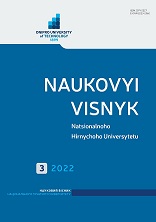
Бази даних
Наукова періодика України - результати пошуку
 |
Для швидкої роботи та реалізації всіх функціональних можливостей пошукової системи використовуйте браузер "Mozilla Firefox" |
|
|
Повнотекстовий пошук
| Знайдено в інших БД: | Реферативна база даних (3) |
Список видань за алфавітом назв: Авторський покажчик Покажчик назв публікацій  |
Пошуковий запит: (<.>A=Kopobayeva A$<.>) | |||
|
Загальна кількість знайдених документів : 3 Представлено документи з 1 до 3 |
|||
| 1. | 
Portnov V. S. Patterns of beryllium distribution in rocks of Central Kazakhstan [Електронний ресурс] / V. S. Portnov, A. N. Kopobayeva, A. Amangeldikyzy, N. S. Askarova // Науковий вісник Національного гірничого університету. - 2019. - № 6. - С. 5-10. - Режим доступу: http://nbuv.gov.ua/UJRN/Nvngu_2019_6_3 Purpose. To establish patterns of beryllium distribution in rocks to identify geochemically specialized rocks in order to improve the effectiveness of regional forecasting aimed at expanding the rare metal base of the country. Methodology. It is based on systematic and mathematical analyses. The basis of the work laid on the system of regional clarkes of Central Kazakhstan, based on these data correlation graphs of interrelations of an element with oxides of various elements in rocks are constructed, by means of which features of Geochemistry of beryllium in geological formations are revealed. Findings. On the basis of the analysis of distribution and established correlations of beryllium in rocks of Central Kazakhstan the geochemical regularities of its distribution in different types of rocks are determined and geochemically specialized rocks in relation to this element are revealed. The patterns of beryllium distribution and factors influencing its distribution in rocks of Central Kazakhstan are revealed. It is established that the terrigenous and metamorphic rocks with the highest content of SiO | ||
| 2. | 
Parafilov V. I. Geochemical specialization of the Shubarkol deposit coals [Електронний ресурс] / V. I. Parafilov, A. Amangeldikyzy, V. S. Portnov, A. N. Kopobayeva, A. D. Maussymbayeva // Науковий вісник Національного гірничого університету. - 2020. - № 5. - С. 5-10. - Режим доступу: http://nbuv.gov.ua/UJRN/Nvngu_2020_5_3 Purpose. Studying the distribution of impurity elements in the coals of the Shubarkol deposit to assess their geochemical specialization, as well as to forecast their industrial potential. Methodology. The research methodology is based on the results of analytical studies carried out by the instrumental neutron activation (INAA) method, as well as microscopic studies carried out on the basis of the nuclear-geochemical laboratory of the Department of Geoecology and Geochemistry of National Research Tomsk Polytechnic University. These data became the basis for establishing the patterns of distribution of impurity elements in coals. Findings. It is found that the coals of the Shubarkol deposit are geochemically specialized in Ba, U, Au, Yb, Ba, Cd, La, Nd, Ce, Zn, Sc, Sr, Zr. The weathered coals of the Eastern section of the deposit contain concentrations of Ce, Ba, Yb, U, Sc, Au that are higher than those in the Central and Western sections and reach industrially significant amounts. Recommendations are given for the extraction from the coals of uranium and rare-earth elements of the yttrium group having industrially significant contents. Originality. Regularities of the impurity elements distribution using the methods of INAA and microscopy are established; the potential of coals as an unconventional source of a number of chemical elements is determined, and the possibility of their complex extraction is evaluated. Practical value. It consists in substantiating the possibility of the integrated use of coal from the deposit, which ensures the development of the country's coal industry. | ||
| 3. | 
Kopobayeva A. N. Tectonic factors of impurity elements accumulation at the Shubarkol coal deposit (Kazakhstan) [Електронний ресурс] / A. N. Kopobayeva, V. S. Portnov, S. P. Kim, A. Amangeldykyzy, N. S. Askarova // Naukovyi visnyk Natsionalnoho Hirnychoho Universytetu. - 2021. - № 5. - С. 11-15. - Режим доступу: http://nbuv.gov.ua/UJRN/Nvngu_2021_5_4 Purpose. To study the features of the paleotectonic development of the area and to construct paleotectonic reconstruction of the deposit formation to establish the nature of impurity elements accumulation in the coals and enclosing rocks of the Shubarkol deposit, as well as to increase the mineral resource potential of coals. Methodology. 25 samples of coal and mudstone from the Shubarkol deposit were analyzed. The samples were studied by instrumental neutron-activation analysis (INAA) at the Nuclear Geochemical Laboratory of National Research Tomsk Polytechnic University. Findings. An analysis of geological-structural and paleotectonic formation conditions of the Jurassic coal deposit was carried. The factors of formation of coal and carbon-containing rocks enriched with impurity elements and the conditions needed for its leaching and transportation to the coal seam were analyzed. It was found that the coals in individual samples have average concentrations of Ce, Ba, Sr, Sc, Zn that are higher than the clarke, and Sm, Ce, U, Cr, Yb, Ba, Sr, Nd, As, Sc, Zn, Eu, La in the composition of mudstone have average values that are higher than in coals, and higher than the clarke. It was established that one of the sources of rare-metal mineralization of coals (peat) in the Mesozoic and Cenozoic times were the rock massifs of the Kokchetau uplift in the north and northwest, the Kaptyadyr, Arganatinsk and Ulutau mountains in the west. They form the chain of the Kokchetau - North Tien Shan ancient folded structure and the Central Kazakhstan (Devonian) volcanic-plutonic belt in the east. They surround the sedimentation basin and serve as suppliers of clastic material during the coal-bearing strata formation due to tectonic processes of the Mesozoic-Cenozoic time. Originality. The paleotectonic development of the Shubarkol deposit area during the coal-bearing formation has been reconstructed. It has been established that the Sarysu-Teniz uplift in the Permian-Triassic is separated into an independent block, to which the studied deposit is spatially and genetically related. It has been established that the distribution of elements in the coals of the Shubarkol deposit is determined by the peculiarities of metallogeny, geochemistry of the framing area and the mechanisms of the elements entering the coal seams. Practical value. A purposeful analysis of materials for the peculiarities of high concentrations of impurity elements accumulation in coal in connection with deep fault zones at the Shubarkol deposit serves as an objective justification of the possibility of their integrated use, ensuring the development of the country's coal industry. | ||
 |
| Відділ наукової організації електронних інформаційних ресурсів |
 Пам`ятка користувача Пам`ятка користувача |